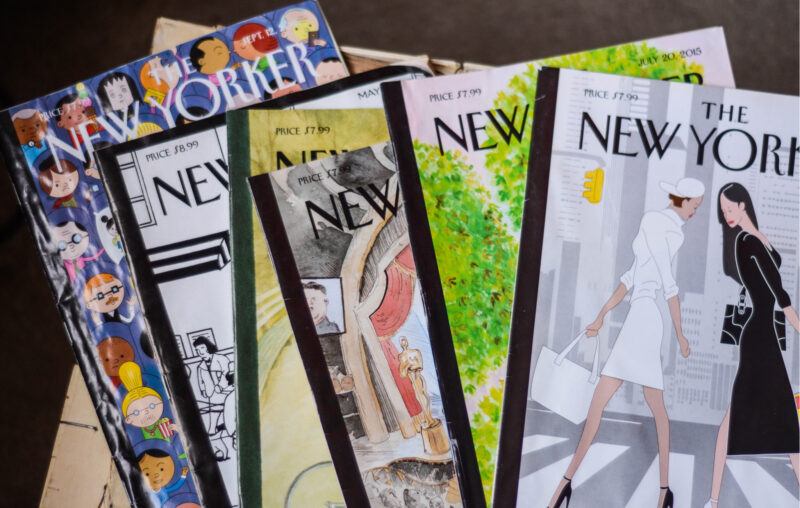The New Yorker “Conundrum”

The New Yorker has a conundrum. That’s a puzzle, an enigma, even a borborigmus, or stomach rumble.
Writing from the heart of the darkness of liberal sentiment about Covid-19, the New Yorker has persisted in the comfortable assurance that President Trump did it. And the mandatory cures? They are obvious: masks, lockdowns, money, quarantines, windmills, and Democrats.
Now Trump has departed along with much of the population of Manhattan. Kennedy Airport is sepulchral and Orlando and Miami are thronged.
Now in office, Biden and his masked gang prepare new plans to raid the central bank (copying the strategy Trump pursued without even the discretion of donning masks).
The New Yorker’s eponymous domains are largely closing down. Even the saintly Governor Andrew Cuomo is succumbing to the voracity of feminist me-too cannibalism.
At the New Yorker, doubts seem to be simmering that all is well. Perhaps, its recent politics above all stance no longer will do.
Time to call 911 for physicians and other scientists.
The magazine is summoning back its expert doctors and other gurus to give readers a post-Trump respite from the somewhat undignified ululations of pure politics (what would E.B. White have said?). Political rants, even in the elegant prose of editor David Remnick, tend to clash with its usually urbane upper-class ambiance.
Providing emergency repairs are the magazine’s sophisticated medical writers Atul Gawande and Siddhartha Mukherjee, who are shoring up the exalted Conde Nash flagship publication’s scientific reputation and pretensions.
Liberalism’s ever mutating arguments for government power are currently focused on the coronavirus and climate change in various blends and vortices. It’s getting complicated. The cover of the current issue bravely shows the city submerged in snow, with the elegant scalloped tower of the Chrysler building peeking forth from the white wasteland like a North Pole.
Featured inside is a perplexed Mukherjee essay on the crazy quilt pattern of Covid’s impact around the globe. Why is the death rate in India one tenth the US rate and the rate in Nigeria one hundredth the US rate?
As he might have added, why in Taiwan, a small island with 24 million people, are total Covid deaths a thousand times lower than in the US?
Mukherjee’s long essay reaches the conclusion that we must eschew simple explanations. He twists and turns through the evidence—perhaps poor countries haven’t been counting all the deaths, haven’t tested enough. Perhaps their immune systems have been prepared by previous viruses. Perhaps their governments acted more decisively and their people were more docile in wearing masks.
He raises all these possibilities and then disparages them with contrary but debatable data.
He concludes that Ockham’s razor (the simplest solution is the best) must give way to Ockham’s quilt (multiple factors are needed to fit the data).
This rather underwhelming answer is followed by a somewhat dyspeptic complaint by Nick Paumgarten in an article about the bureaucratic twists and turns of state policy on restaurants. The state (and city) banned indoor dining in New York in the face of a foot of snowfall (which the New Yorker’s more gullible readers are well-trained by its editors to recognize as further confirmation—as if any is needed!—of the relentless depredations of climate change).
“Justifiable in epidemiological terms,” concedes the carefully politically-correct Paumgarten. Nonetheless, he observes, the ever-changing rules are “no picnic” for Manhattan’s restaurants that have erected “sheds, tents, lean-tos, stables, barns, bubbles, teepees and yurts, as well as the heating appliances, the planters and plastic flowers, the canopies of fairy lights and power cords, the wooden gangways and plexiglass dividers” for outdoor dining.
“No one really knew for sure what was allowed and what wasn’t, in the event of snow. Were they required to dismantle everything?”
“For months, restaurants had endured a baffling crossfire of changing rules and regulations, from a gantlet of city and state agencies. That week the Mayor’s counsel had issued a memo stating that, under the Governor’s new indoor dining ban, patrons dining outside were prohibited from going inside to use the restroom.”
The New Yorker offered a canonical quote: “‘It has become increasingly clear that the government is run by a bunch of clowns,’ Eric Tze, the owner of 886, a Taiwanese restaurant on St. Marks Place, said recently.’”
Hey, I couldn’t have said it better myself. Is it possible that The New Yorker may be entertaining doubts about its sophomoric socialism?
Back to Mukherjee and his abandonment of Ockham’s rule of parsimony. Like Agatha Christie’s Murder on the Orient Express, where there was a conspiracy of culprits gathered to murder the ultimate culprit-victim, there’s no single culprit but many to explain the radically unequal ravages of Covid. (This will be a surprise to The New Yorker clientele and presumably a relief to former culprit-supreme President Trump.)
As Mukherjee quotes one expert after another, I awaited in vain the citation of another Indian writer, Sunetra Gupta, the eminent Oxford epidemiologist, author of a book on the history of pandemics, and acclaimed writer of several novels.
Reading Gupta, one of the authors of the Great Barrington Declaration, signed by some 40,000 doctors and other authorities under the aegis of AIER, I had come to the realization that the explanation was actually simple, that Ockham still applies.
The simple explanation is that the incidence and severity of pandemics has steadily declined over the decades of globalization, as immigration, tourism, air travel, trade and other intercourse among peoples has trained our immune systems to recognize new threats.
Previous pathogens had caused extinction events like the Bubonic Plague and other viral and bacterial catastrophes that kept world population a tenth of today’s. But since the Spanish flu after World War I that killed some 50 million, more recent epidemics have been relatively mild, or else deadly, like SARS, but relatively uninfectious.
Today the world population of some 8 billion attests to the new robustness of immune systems. Most of us can readily deal with Covid-19 and whatever viral threat may follow it.
However, the reason for our immunity is not quarantine-of-the-healthy, lockdowns, masks and xenophobic sequestration but exposure, trade, openness and interaction. Gupta fears that our remedies are historically retrograde. They will create a new dark age for immune systems and could summon the very extreme events that we most fear.
As the UN predicted, the worldwide economic depression caused by the lockdowns has wreaked havoc in the Third World, with a high level of deaths from starvation and other causes. In rich nations, with obsessive and constant testing, we are ascribing almost all mortality to Covid and we will ascribe the abatement of Covid to vaccinations. (Hey, I’ve had two shots from Moderna. You’re safe to read this and pass it on!)
My prophecy: The New Yorker will return to its anguished stress on climate change, which may relieve it from following up on Paumgarten’s felicitous clowns-in-government theme until the lights start going out.
Meanwhile, we can return to Judy Collins’ favorite: “Send in the Clowns.” They’re always on the ready. As New Yorker “poet,” actually prose-writer Gregory Pardlo, intones in a vivid Allegory about a Professional wrestler dying in an accidental fall in Kansas City: “To take myth as history, semblance as creed. A grift so convincing one might easily believe it could work without someone else pulling the strings.”











